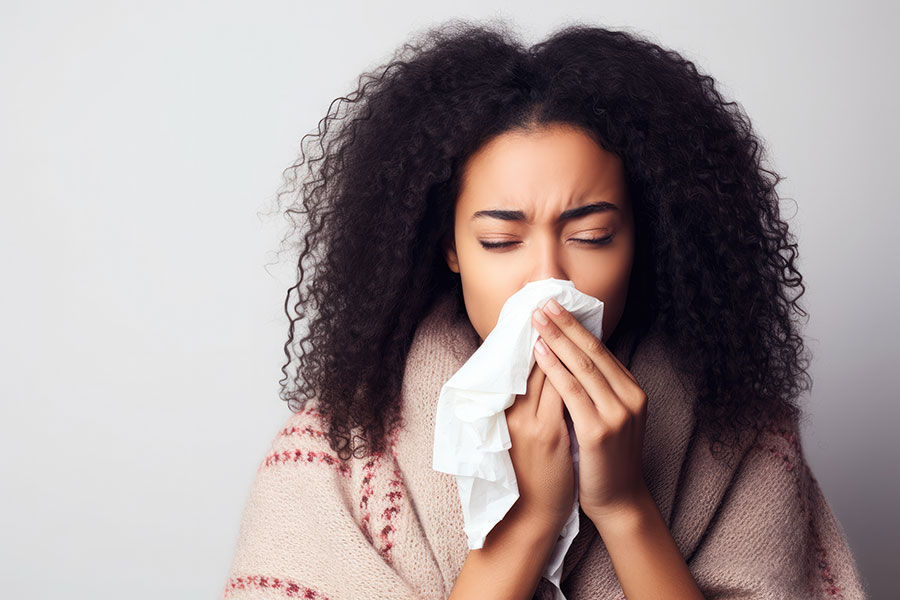Treating the Common Cold
Ah, the common cold, or as some like to call it, the “acute coryza.” It’s basically the VIP of upper respiratory inflammation, brought to you by none other than our viral buddies. Move over, other diseases; the common cold is the real frequent flyer, making itself at home more often than your nosy neighbor visits uninvited. On average, you get to cozy up with this delightful ailment three times a year. It’s like a seasonal subscription, but instead of receiving exciting packages, you get a runny nose, a sore throat, and the uncanny ability to make a box of tissues disappear faster than a magician with a deck of cards. Symptoms: Initial cold cues include a throat feeling sore and nasal passages getting congested. While typically starting in the nose and throat, this ailment extends its reach to all body parts. Common symptoms encompass a runny nose, sneezing, a temperature rise, headache, throat discomfort, chills, body aches, and reduced appetite. The skin around the nostrils might also experience soreness. Causes: The common cold stems from exposure to a virus, with its severity influenced by an individual’s health status and environmental factors. Factors like lowered vitality, allergic issues in the nose and throat, body chilling, insufficient sleep, feelings of gloom, fatigue, and abrupt changes in temperature, as well as exposure to dust and other irritating inhalations, play a significant role in cold development. Yet, the true culprit behind a cold lies in the body’s toxic state, a consequence of poor eating habits involving excessive starch, carbohydrates, proteins, and other acid-forming foods. A cold, in essence, serves as nature’s straightforward method of purging toxic waste from the human system. The duration of the cold hinges on the accumulated amount of toxins in the body and how swiftly they are expelled. Treatment: Treating a cold with conventional suppressive drugs doesn’t do you any favors; it just sets the stage for potentially more severe trouble down the road. This kind of treatment abruptly halts the body’s natural elimination process, pushing toxic matter back into the tissues. Plus, let’s not kid ourselves – popping pills won’t magically shrink the cold’s timetable. As the saying goes, you can medicate it and wait a week or let it ride out for seven days. For a genuine cold remedy, look no further than a proper diet. Kick off the treatment with a two-day fast, sipping only warm water with lemon juice and honey or fruit juice mixed with hot water. Flood your system with large quantities of fruit juice to neutralize that acidic blood condition, and throw in some hot drinks to give your kidneys a helping hand. Pineapple juice, in particular, works wonders. Don’t forget a daily warm water enema to keep those bowels squeaky clean during this period. After the quick juice fast, transition to an exclusive fresh fruit diet for three days. Load up on juicy fruits like apples, pears, grapes, grapefruit, oranges, pineapple, peaches, melon – you name it, as long as it’s in season. Bananas, dried or stewed fruits, or anything from a can should not be taken. Add anything else, and you’ll just spoil the therapeutic party. Post-fruit fiesta, ease into a well-balanced diet featuring seeds, nuts, grains, vegetables, and fruits. Take a brief hiatus from meat, fish, eggs, cheese, and starchy delights. To fortify the whole system, indulge in a diet that serves up a buffet of vitamins and minerals, with Vitamin Cgetables, and sprouted Bengal and green grams. Lime takes the spotlight among home remedies for the common cold. Dilute lime juice in warm water, add a teaspoon of honey, and voilà – a potent elixir that amps up resistance, reduces toxicity, and shortens the illness’s duration. Take it as a soothing tonic for a cold and dry cough. For a blast from the past, consider garlic soup as an ancient remedy. Garlic’s antiseptic and antispasmodic properties work wonders, flushing out toxins and helping lower fever. If you’re feeling daring, mix garlic oil with onion juice, dilute with water, and sip throughout the day for a one-two punch against the common cold. Ginger is another hero in the food remedy saga. Boil ginger pieces in water, strain, add half a teaspoon of sugar, and drink it hot for a cold. Ginger tea, made by tossing a few ginger pieces into boiling water before adding tea leaves, is a trusty companion against colds and fevers from colds. Turmeric, with its antiseptic powers, is a valuable ally against colds and throat irritations. Mix half a teaspoon of fresh turmeric powder in 30 grams of warm milk, and you’ve got a handy prescription. Inhaling the smoke from burning turmeric is a secret weapon for a running nose, speeding up relief. Water Treatment: Taking a hot water bath, as long as it doesn’t involve unnecessary exposure, is recommended to ease congestion in the chest and nasal membranes. Hot packs or fomentations work wonders for chest and head colds. Don’t underestimate the power of a steam bath, hot foot bath, and hot hip bath – they stimulate perspiration and can be your allies. Steam inhalation is a go-to for relieving nasal tissue congestion. When a sore throat is in the mix, gargling with hot water and salt is your friend. Incorporating cold chest packs two or three times a day works like a charm, relieving lung congestion and helping clear out that pesky mucus. In the cold-busting arsenal, consider a mild sunbath, getting some fresh air, practicing deep breathing, going for brisk walks, ensuring sound sleep, and adjusting your clothing and habits to match the season – all key strategies to counteract the whims of the weather. Now, let’s not forget the yogic wonders in the battle against the common cold. Yogasanas like bhujangasana, shalabhasana, dhanurasana, and yogamudra in vajrasana, coupled with yogic kriyas such as jalneti and vamandhouti, and pranayamas like kapalbhati, anuloma-viloma, and suryabhedana, all come to the forefront as beneficial treatments for the common cold. It’s like a holistic approach to telling that cold to hit the road.Source: Health Library (archives)



















